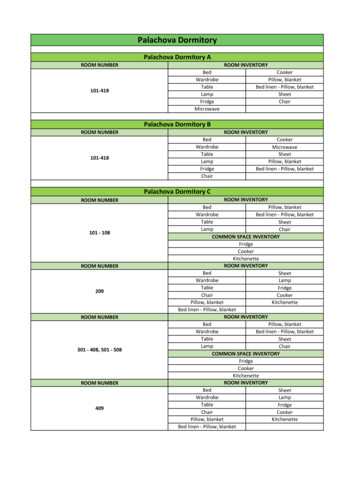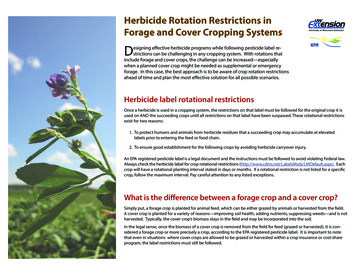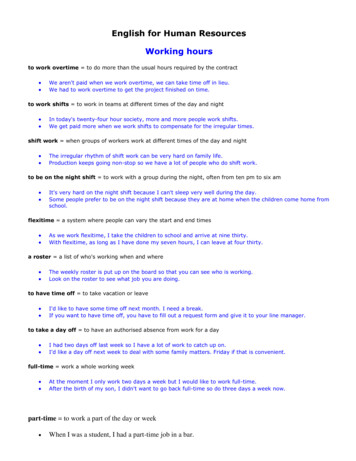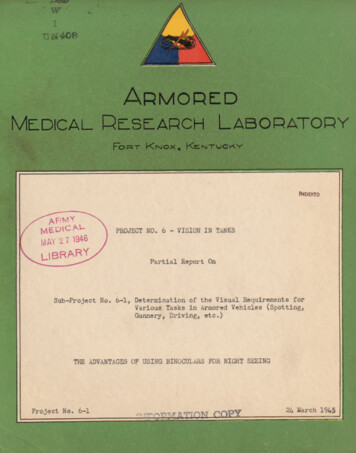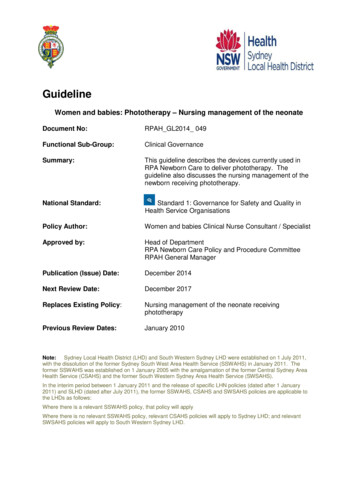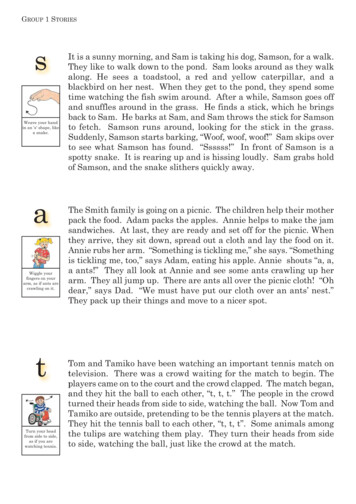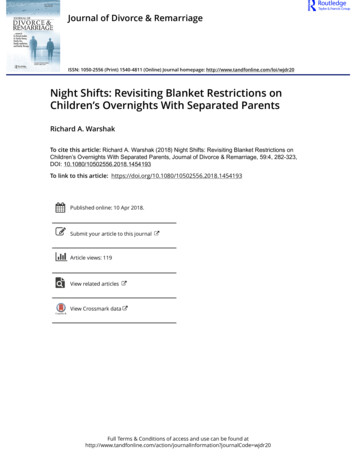
Transcription
Journal of Divorce & RemarriageISSN: 1050-2556 (Print) 1540-4811 (Online) Journal homepage: http://www.tandfonline.com/loi/wjdr20Night Shifts: Revisiting Blanket Restrictions onChildren’s Overnights With Separated ParentsRichard A. WarshakTo cite this article: Richard A. Warshak (2018) Night Shifts: Revisiting Blanket Restrictions onChildren’s Overnights With Separated Parents, Journal of Divorce & Remarriage, 59:4, 282-323,DOI: 10.1080/10502556.2018.1454193To link to this article: shed online: 10 Apr 2018.Submit your article to this journalArticle views: 119View related articlesView Crossmark dataFull Terms & Conditions of access and use can be found tion?journalCode wjdr20
JOURNAL OF DIVORCE & REMARRIAGE2018, VOL. 59, NO. 4, 4193Night Shifts: Revisiting Blanket Restrictions on Children’sOvernights With Separated ParentsRichard A. WarshakDepartment of Psychiatry, University of Texas Southwestern Medical Center, Dallas, Texas, USAKEYWORDSABSTRACTProfessional opinions have shifted regarding the value ofyoung children receiving overnight care from each parent.Contemporary proposals of blanket restrictions are contradictory and rest on faulty interpretations of a narrow bandwidthof scholarship. No coherent theory or research confirms speculations that fathers’ overnight care poses greater risks to theiryoung children than daytime care, or that overnights are contraindicated if opposed by the mother. Theory, research, andpractical considerations support the benefits of overnights. Itviolates logic and common sense to welcome father–childcontact around bedtime and morning rituals when parentslive together, but eschew overnight contact when parentsseparate.child custody; joint custody;overnights; parenting plans;shared parentingPrologueA young couple returned home from the hospital with their firstborn son,thrilled but anxious about their new roles in life. To best meet their baby’spsychological needs, they sought guidance from parenting books and theirpediatrician’s nurse practitioner. The advice was consistent: Be sensitive, bepredictable, be affectionate, and be timely. Spend plenty of one-on-one “facetime.” Play with your son. Share the parenting when your baby is hungry, wet,tired, or ill. No expert suggests that parents count the number of diapers eachchanges, or the number of times each gets up in the night to soothe the baby.No expert cautions the parents to limit the father’s contact with his child.All parents need breaks from child care, and parenting experts advise thatwhen both parents are unavailable, they should select child care providerswho have the time, desire, and skill to engage in sensitive, one-on-one timewith the infant. This couple enlisted the help of eager grandparents, experienced at raising children, who decorated a spare bedroom as a nursery anddoted on their grandchild. When the grandparents were unavailable, theparents used a day care center that promoted children’s emotionaldevelopment.CONTACT Richard A. WarshakUSA. 2018 Taylor & Francis Group, LLCdoc@warshak.com1920 N. Coit Rd., Suite 200-203, Richardson, TX 75080,
JOURNAL OF DIVORCE & REMARRIAGE283As is true in a majority of U.S. families, both parents were employed (U.S.Department of Labor, Bureau of Labor Statistics, 2017), keeping them awayfrom the baby at least 45 hours each week. Some weeks the parents maximized their time with their son by synchronizing work schedules so that oneparent remained at home during the day while the other parent worked anevening or night shift, a practice known as tag-team parenting (Boushey,2006; Fox, Han, Ruhm, & Waldfogel, 2013).Ten months later, the wife filed for divorce. Each spouse retained a lawyer.Both lawyers asked their clients to consult a child specialist to discuss aparenting plan. The father’s consultant told him to maintain continuity ofcare. Because his son is accustomed to both parents’ care, sees them daily,and has a relationship with both parents, the boy needs to continue seeingboth parents frequently to maintain his existing relationships and broadenthe foundation for his future relationships with his parents. Although, withthe parents living apart, it might no longer be practical for the child to seeboth parents every day, neither parent should go more than 2 or 3 daysbefore spending time with their son.The consultant suggested that for the next 2 years the parents divide eachweek into three blocks of time and alternate the blocks between parents:Block 1 is Monday and Tuesday. Block 2 is Wednesday and Thursday. Block3 is Friday, Saturday, and Sunday. This plan gives each parent every otherweekend with the boy.The mother’s consultant gave very different advice. This consultant holds adouble standard about shared parenting: one guideline for parents who livetogether; a different one for those who separate. The mother’s consultant toldthe mother to spend as much time as possible with her baby and insisted thatthe more time the baby is away from her, the greater the risk to the child’sdevelopment. The consultant claimed to value the father’s contributions tothe child’s development, but believed that the father should cut back on thefrequency and amount of contact for the next few years and then gradually“step up” his overnight child care and parenting time. The expert wasconvinced that all babies need to sleep every night in the same crib, in thesame room, in the same home. The expert recommended, for now, that thefather should reduce his contact to 2 days per week from the current 7 days:2 hours on Wednesday, 4 hours on Saturday, but rarely, if ever, overnight.Initially, these parents thought they would part ways amicably, but theconsultants’ conflicting advice triggered a custody dispute. Both parentsbecame anxious at the prospect of losing time with the child and worriedthat the custody arrangement sought by the other parent would harm theirson. As the custody dispute heated up, the parents began to devalue eachother’s parenting skills and minimize their spouse’s past involvement inchild-rearing. The mother interpreted her son’s normal, but troubling, toddler behaviors as symptoms of being away too often from her and spending
284R. A. WARSHAKtoo much time with his father. The father attributed the same behaviors tohis son not spending enough time with him. The parents no longer trustedeach other to make decisions that were best for their son.The issuesThe consultants’ opinions mirror differences among scholars and policymakers on two issues. The first issue is whether young children are betteroff spending most of their time with one parent or more evenly balancingtime between parents in a shared physical custody arrangement generallydefined as at least 35% time living in each home. The second issue is whetherall young children are better off receiving overnight care from only oneparent or whether some children benefit from being in the overnight careof both parents.Scholars regard these overnight policies and decisions as high-stakesissues. On the one hand is the concern that denying children more overnightcare and contact with their fathers weakens the foundation of the paternalrelationship and could leave emotional deficits that cannot be overcomewhen overnights begin after age 4. On the other hand is the concern thatadditional overnight care from the father away from the mother exacts a tollby undermining the security of attachment with the mother. Rather thanfostering the child’s healthy relationship with both parents, overnight sharedphysical custody might leave children without a single healthy attachment.OverviewThis article updates an earlier treatment of blanket restrictions regardingovernights for young children (Warshak, 2000). The first sections clarifyterminology, offer a brief history of blanket restrictions, and discuss shiftsaway from and back toward restricted overnights. Proposed restrictions shiftfrom researcher to researcher and sometimes shift from one article toanother by the same writer. The article examines the relationship betweenattachment theory and blanket restrictions with particular attention to ahierarchical attachments model, concerns about mother–child separations,and rationales offered for claims that fathers’ overnight care poses greaterrisks to young children than daytime care. Next, the analysis contrasts thehierarchical model of attachments with a heterarchical model, and discussesthe manner in which overnights contribute to attachments.The article then moves beyond attachment theory, adopting a bioecological framework in addressing a broad range of factors and contexts thatimpinge on children’s development (Bronfenbrenner, 1986; Bronfenbrenner& Ceci, 1994). The article demonstrates why a wide range of research isrelevant to the issue of overnights, and contrasts the “wide lens” approach
JOURNAL OF DIVORCE & REMARRIAGE285with one that defends blanket restrictions based on three seriously flawed,but influential studies. The analysis exposes the weakness of the case forblanket restrictions built on these three studies. Next the article describes aconsensus on shared parenting and overnights for young children that waspublished in reaction to the growing influence of misinformation on custodydecisions.Recent efforts to promote blanket restrictions are discussed, includingproposals that overnights should be restricted when parents dispute custody.The article then describes sleeping arrangements for children that are considered normal when parents live together but alarm some professionalswhen parents separate. Finally, a discussion of the ecology of overnightsdraws attention to benefits that are sometimes overlooked by proponentsof blanket restrictions.Disputes among professionals regarding the wisdom of overnights oftenbecome heated. Some professionals have personalized what should remainacademic disputes, impugned the motives of those with whom they disagree,and likened the disagreements to a war (see, e.g., quotations in Arndt, 2014;McIntosh, 2014). Yet it is clear that researchers and practitioners, who devotetheir careers to understanding and helping children and families, share thecommon goal of improving the well-being of those whose lives they studyand attempt to help. In the case of overnights, all contributors to the debatewant children to have secure relationships with their parents and optimalcircumstances for their future development. Without pulling intellectualpunches, this article aims for a scholarly, nonpolemical tone.A note about the title. “Night Shifts” highlights six key “shifts” this articleaddresses: (a) the shift between homes where the child spends the night, (b)separated parents sharing night shifts with the child, (c) shifts over time incultural and professional views about issues related to overnight sharedparenting, (d) shifts over time in positions about overnights held by thesame individual, (e) married mothers employed on night shifts who leave thefather to care for the child overnight, and (f) shifts between acceptingsituations as normal in families before divorce but unacceptable after divorce.Clarifying terminologyDiscussions of parents who live together refer to the mother and father, or inthe case of same-sex parents, the mothers or the fathers. Some studies ofseparated parents, striving to avoid gendered language, refer instead toprimary and nonprimary caregivers. This could be misleading if nearly allof the study’s primary caregiver group were mothers (e.g., McIntosh, Smyth,& Kelaher, 2015). Most disputes about overnights involve a father who wantsmore overnights; thus, this article’s discussion assumes rather than obscuresthis fact. For the small percentage of cases where the child lives primarily
286R. A. WARSHAKwith the father and the mother wants more overnights, the reader shouldsubstitute father for mother, and in an even smaller percentage of casesinvolving same-sex parents, the reader should use fathers or mothers (plural).Most of the theoretical and practical considerations about blanket restrictionsapply to these less prevalent situations.Two terms, caution and frequent, often invoked when professionals recommend overnight restrictions, warrant attention. Some proponents of blanketrestrictions frame their recommendations as a caution against overnightsrather than an absolute prohibition. Presumably the term is used to indicatethe desirability of a flexible as opposed to rigid application of the guideline.Caution signifies a hazardous situation that does not necessarily need to beavoided, but requires extra care and attention to steer clear of harm. Whenprofessionals advise parents to be cautious about a child spending one ormore overnights per week in a second home, however, decision makers whobelieve that the caution has scientific support treat the caution as a mandateto avoid overnights.The second term that professionals might invoke in connection withblanket restrictions is frequent. Two studies used frequent to designate asfew as four overnights per month (McIntosh, Smyth, & Kelaher, 2010;Tornello et al., 2013). When proponents of blanket restrictions cite thesetwo studies to support their opposition to frequent overnights, what theymean by frequent is not generally considered frequent by a child orfather.Blanket restrictions through the agesUntil well into the 19th century, common law gave married and divorcedfathers complete and absolute custody and control over their children. Formany families the question of which parent cared for the child overnight wasa nonissue: Those who could afford it, especially those who lived in cities,outsourced care of their infants and toddlers to wet nurses whose countrysidehomes were regarded as healthier for young children. Mothers did not thinktheir presence was necessary for their young children to thrive. Judging fromautobiographies of the period, the concept of emotionally intensive mothering emerged sometime later in the 19th century (“What 19th CenturyWomen Really Did,” 2014).The idea that mothers are by nature uniquely suited to nurture childrenbegan taking hold in the second half of the 18th century, spread in the 19thcentury, and eventually penetrated law governing child custody (Stone,1990). What became known as the tender years doctrine gave courts theauthority to award mothers custody of children under the age of 7. Overtime the doctrine expanded to include children of all ages (Commonwealth v.
JOURNAL OF DIVORCE & REMARRIAGE287Addicks, 1813; for additional case law and legislation expressing the tenderyears doctrine see Warshak, 2011).A legal presumption in favor of mother custody remained throughout the19th century and most of the 20th century. Most divorced fathers saw theirchildren at the mothers’ discretion, a gatekeeping policy advocated in anacclaimed book by Goldstein, Freud, and Solnit (1973/1979). Drawing onideas from Freud (1940) and Bowlby (1951/1952, 1969), Goldstein et al.hypothesized that children have one psychological parent who should retainsole custody in the event of divorce, and asserted that children cannot benefitfrom contact with two parents who are in conflict with each other. Bowlby’sand Goldstein et al.’s ideas were the basis for excessive concerns about separating young children from their mothers, even brief separations such as thoseoccasioned by leaving the child with a father, babysitter, or day care attendant.The Uniform Marriage and Divorce Act (UMDA, 1973) proposed thegender-neutral best-interest-of-the-child standard. Nevertheless, the legacyof the tender years presumption was evident in the comments to the UMDA:“The preference for the mother as custodian of young children when allthings are equal, for example, is simply a shorthand method of expressing thebest interest of children.” The tender years doctrine legacy also was apparentin blanket restrictions prevalent between 1980 and 2000. Despite custodypolicy that stressed the importance of frequent and continuing contactbetween children and both parents, infants and toddlers continued to bedenied their father’s overnight care, a practice consistent with the prevailingprofessional judgment of the time (Warshak, 2000).Research from the 1970s to the 1990s revealed that most children neededand wanted more contact with their fathers after divorce than they weregetting (Braver & O’Connell, 1998; Hetherington, Cox, & Cox, 1982;Hetherington & Kelly, 2002; Santrock & Warshak, 1979; Wallerstein &Kelly, 1980; Warshak, 1986, 1992; Warshak & Santrock, 1983). In 1994, 18experts sponsored by the U.S. National Institute of Child Health and HumanDevelopment (NICHHD) met to evaluate the divorce research literature. Thegroup subsequently issued a consensus statement concluding that to “keepnonresidential parents playing psychologically important and central roles inthe lives of their children,” distribution of custodial time should ensure “theinvolvement of both parents in important aspects of their children’s everydaylives and routines—including bedtime and waking rituals, transitions to andfrom school, extracurricular and recreational activities” (Lamb, Sternberg, &Thompson, 1997, p. 400).Shifting away from blanket restrictionsArticles published in Family Court Review between 2000 and 2002 challengedguidelines that restricted young children from sleeping in their father’s home.
288R. A. WARSHAKA group of authors extended the NICHHD consensus to young children bysupporting flexible, individualized parenting plans rather than proposingabsolute rules favoring or prohibiting overnights (Gould & Stahl, 2001;Kelly & Lamb, 2000; Lamb & Kelly, 2001; Warshak, 2000, 2002). Thoseauthors recommended that decision makers consider the option of overnights because of the potential benefits to the foundation of stable andlifelong parent–child relationships.In contrast to these blanket restriction challenges, Solomon and Biringen(2001) cited only one empirical study (Solomon & George, 1999a, 1999b), todefend their view: “Repeated overnight separations present a greater challenge to the development of organized primary attachments than do daytimeseparations” (p. 357). They added, “The available evidence, albeit scarce,indicates that separations from the mother should still be viewed withcaution, particularly where nighttime separations are concerned and untilmore empirical evidence is gathered” (p. 359). Despite their caution,Solomon and Biringen (2001) did acknowledge, “Even separations of a fewdays from the primary caregiver seem to be well tolerated when conditionsare supportive” (p. 361).In their rejoinder, Lamb and Kelly (2001) referred to extensive literaturethat demonstrated that U.S. infants generally form attachments to bothparents at about the same age. They also emphasized that overnights offerunique opportunities for relationship-building interactions that reduce therisk of severed or attenuated father–child relationships and that the Solomonand George study provided a poor foundation for public policy: “The evidence suggests that overnight separations from one parent in order to bewith the other strengthen rather than harm attachment relationships” (Lamb& Kelly, 2001, p. 368).Biringen et al. (2002), however, asserted that children have a hierarchy ofattachment figures of unequal salience. They interpreted the Solomon andGeorge (1999a, 1999b) results as showing that “overnight visitations did notimprove the infant-father attachment and actually harmed the infant-motherattachment” (p. 206). They did offer the concession, “We do not claim thatovernight visitations are necessarily bad for infants/young children, merelythat the empirical findings currently available suggest that until we havemore information, we should proceed with caution” (p. 206).Warshak (2002) concluded that the literature on parent–child relationships and on the impact of divorce on children, supports a best-interestsbased flexible and individualized approach to overnights: “The data showthat overnights should be among the options considered for infants, toddlers,and older children. Overnights should neither be made mandatory nor beroutinely excluded” (p. 217). Warshak based his conclusions on severalconsiderations, including theoretical work on the establishment and growthof parent–child relationships; empirical studies on parent–child relationships
JOURNAL OF DIVORCE & REMARRIAGE289and on the protective and risk factors linked to the impact of divorce onchildren; common experience of infants sleeping apart from their mothersin day care, with babysitters, with fathers, with grandparents, and so on; andthe common sense logic that, if young children sleep during the day apartfrom their mother with no harm, it is unlikely that sleeping at night apartfrom their mother brings special risks.The difference that emerged from the Family Court Review exchanges wasone of emphasis. All the authors agreed that the prevailing empirical literature did not contraindicate overnights and did not support blanket restrictions against any overnights. One side interpreted the literature to emphasizethe potential value of overnights. The other side emphasized the potentialrisks.Shifting back to blanket restrictionsThe decade following these exchanges saw greater acceptance of fathers’overnight care (Kelly, 2005). This remained the case until 2011 whenMcIntosh (2011b) advocated a renewal of blanket restrictions. Based onone report (McIntosh et al., 2010) copyrighted by the clinic she founded,along with her mistaken interpretation of Solomon and George (1999a,1999b), McIntosh (2011b) concluded, “In early infancy, overnight stays arecontraindicated, undertaken when necessary or helpful to the primary caregiver, and when the second parent is already an established source of comfortand security for the infant” (p. 4, italics added). McIntosh (George, Solomon,& McIntosh, 2011) said, “On the basis of my research and clinical experience,I am cautious about regular overnights [1–3 nights monthly] for under twos[by which McIntosh means until the third birthday]. I am also conservative about equal shared overnight care prior to age six” (p. 525).As guest editor of a special issue of Family Court Review, McIntosh(2011a) claimed that the attachment experts she had invited to contributearticles concurred: “Overnight stays away from the primary caregiver in earlyinfancy are generally best avoided, unless of benefit to the primary caregiver”(p. 424). For example, Sroufe told McIntosh, “Prior to age 18 months, overnights away from the primary carer [sic] should be quite rare” (Sroufe &McIntosh, 2011, p. 472). Several scholars (Kelly, 2014; Lamb, 2012; Ludolph,2012) criticized McIntosh for choosing commentators who failed to representthe range of opinions among attachment scholars.McIntosh gave no explanation of why overnight stays, which she believesare contraindicated and presumed harmful, become acceptable when theybenefit the primary caregiver. This guideline could suggest that if the motherfelt that having a night away from her child would benefit her, this wouldoutweigh the presumed costs of the separation to the child. Or this guidelinecould reflect the belief that it is not separation from the mother that causes
290R. A. WARSHAKharm, but separations against the mother’s wishes. Regardless of its rationale,this guideline makes one parent the gatekeeper of overnights, resurrectingGoldstein, Freud, and Solnit’s long-discarded policy of giving sole discretionto one parent to regulate the other parent’s access to the child. Given the verylow incidence of courts designating fathers as primary parents, McIntosh’sguideline privileges mothers in decisions about physical custody.Contemporary blanket restrictions: Shifts and inconsistenciesSince 2011, McIntosh has modified her position on blanket restrictions,acknowledging that “clinical and theoretical cautions against any overnightcare during the first three years have not been supported” (Pruett, McIntosh,& Kelly, 2014, p. 250). Nevertheless, she continued to advocate restrictions,although not complete prohibitions of overnights. Part 1 of a two-part articlethat McIntosh coauthored recommends “caution” about “high frequency”overnights for children younger than 4 years, particularly under certainconditions, such as when parents cannot agree on the parenting plan(Pruett et al., 2014, p. 250). Recall that “cautions” about practices that canharm babies become “prohibitions” in most parents’ minds, and “highfrequency” to these researchers means as few as five overnights per month.Part 2 of the article shifts from the recommendation made in Part 1 in threecrucial ways: (a) a shift from “caution” about more than four overnights permonth to a more definite “not generally indicated”; (b) a shift from conditions that reinforce the restrictions (e.g., parental disagreement) to unconditional application to all parents—even those who consistently and sensitivelymeet their children’s needs; and (c) a shift in the target range for blanketrestrictions from ages 0 to 4 years to 0 to 18 months (McIntosh, Pruett, &Kelly, 2014, p. 57). No explanation was offered for these significant shiftswithin their two-part article.From their article, McIntosh and Pruett developed an instrument,Charting Overnight Decisions for Infants and Toddlers (CODIT), that theyhave since been promoting as a guide for parents and professionals(McIntosh, 2015; Pruett, 2015). CODIT includes a proscription against“high frequency” overnights (more than four per month) for infants youngerthan 18 months, but the authors shifted their previous recommendation byapplying the restriction only to infants who are subject to family law disputes.McIntosh and Pruett offered no explanation for the shift.Pruett further shifted her recommendation, in a chapter authored separately from McIntosh, by narrowing the circumstances for caution to situations in which the parents’ disagreement “interferes with the child’s care”(Pruett, Cowan, et al., 2016, p. 97). That is, Pruett no longer maintained thatthe mere presence of a dispute over custody is sufficient to be cautious aboutovernights. Kelly (2014), writing separately from Pruett or McIntosh,
JOURNAL OF DIVORCE & REMARRIAGE291explicitly rejected the proposal that the presence of conflict between parentsjustifies blanket restrictions, advocating, instead, remedies to reduce thechild’s exposure to high parental conflict.Although the authors just discussed presented their recommendations andthe CODIT instrument as though they were based on child developmenttheory and research, the shifts, inconsistencies, and contradictions in theirrecommendations expose the lack of an objective scientific foundation forsome of these proposals. For instance, McIntosh offered five inconsistentrecommendations. Although it is not unusual for a scientist to revise herviews, McIntosh has not repudiated in writing her past proposals or acknowledged that she has revised her opinion. Instead, she asserted that her positionwith respect to blanket restrictions has not changed (McIntosh et al., 2015).Other scholars have also shifted their views about overnight policies. Forexample, Emery’s (n.d.)online “Alternative Parenting Plans (Child CustodySchedules)” proposes multiple schedules with blanket restrictions. For children younger than 18 months, these schedules range from no overnights andno more than 6 hours of contact with the father each week when parentshave a “distant” or “angry” divorce, to a maximum of two overnights permonth when parents have a cooperative divorce. Emery believes that everycouple in custody litigation is a high-conflict couple unsuitable for sharedparenting (Emery, 2014; Jackman, 2010). In a book for the general public,Emery (2016) defended blanket restrictions by citing a study he led. Yet in ajournal article the same year, Emery shifted from this defense, stating thatthere was “an inadequate body of research upon which to speculate aboutpolicy implications” for overnights (Emery et al., 2016, p. 144).Another example of shifting recommendations is found in Smyth’s work.Writing with McIntosh and Kelaher, Smyth cautioned against more than oneovernight per week for infants and toddlers (McIntosh et al., 2010, 2015). Inan earlier article (Smyth & Ferro, 2002), though, Smyth praised overnights asproviding “opportunities to engage in an array of interactions and functionalcontexts that are usually not possible in day-time contact” (p. 58) and helpingto “foster the development of close emotional bonds between children andnon-resident parents” (p. 54).Attachment theoryScholars who believe that science supports blanket restrictions, and thosewho believe the opposite, each reference attachment theory to frame aportion of their analyses (Ainsworth, 1982; Bowlby, 1969). This theoryproposes that attachments develop from regular and reciprocal parent–child interactions that enable the infant to discriminate parents from otherpersons. For example, when parents sensitively and consistently respond totheir baby’s behavior (e.g., cries), the baby experiences them as reliable, and
292R. A. WARSHAKthis nurtures a secure attachment. The sine qua non for attachment formation is ample opportunity for the child to interact with a parent and for theparent to regularly provide love and care. Attachment theory further proposes that children encode these relational experiences into an internalworking model of themselves, of other people, and of the nature of relationships. These internal models then influence children’s regulation of emotionsand subsequent adjustment, such as early attachment security predictinghigher quality interpersonal relationships and fewer behavior problems.Despite professionals’ agreement on some aspects of attachment theory,th
Children's Overnights With Separated Parents, Journal of Divorce & Remarriage, 59:4, 282-323, DOI: 10.1080/10502556.2018.1454193 . married mothers employed on night shifts who leave the . and (f) shifts between accepting situations as normal in families before divorce but unacceptable after divorce. Clarifying terminology Discussions of .
